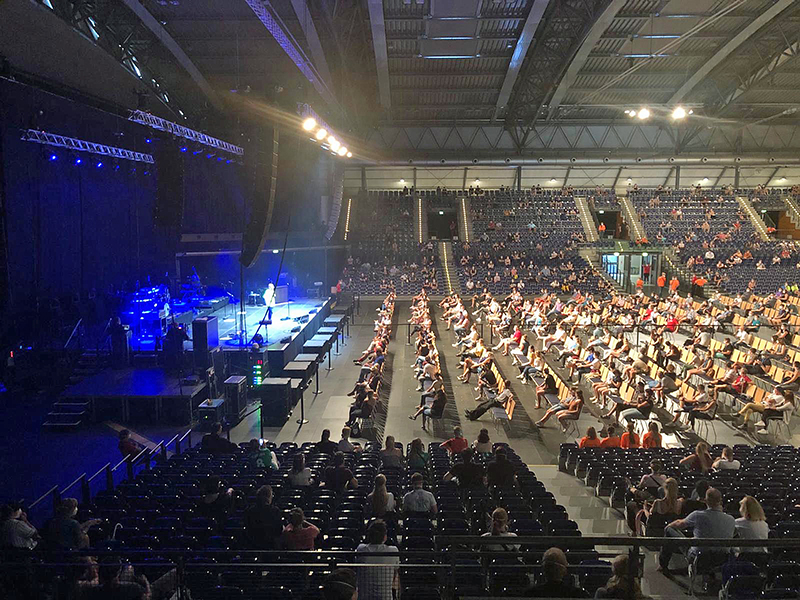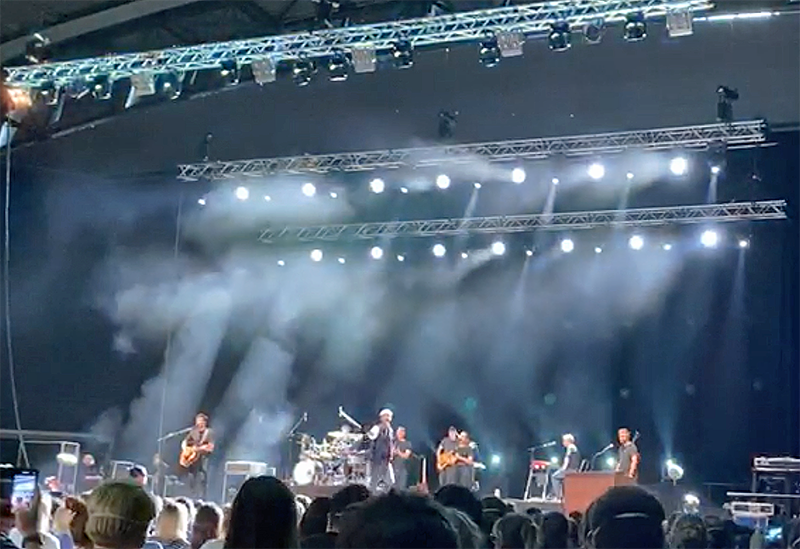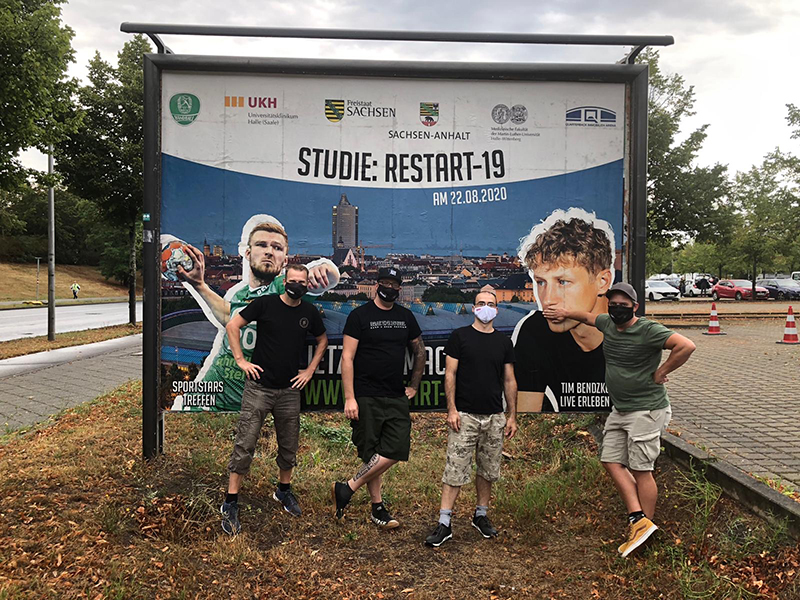
On Saturday, Aug. 22, a three-part concert featuring pop artist Tim Bendzko was held at the Quarterback Immobilien Arena in Leipzig, Germany. The audience members volunteered to take part in the all-day event, with close to 1,400 welcoming the opportunity to experience a live concert once again as scientists used the event to collect data on the spread of Corona-19 virus particles in a real-world setting.
The scientists at 500-year-old Martin Luther University at Halle-Wittenberg designed the study to keep the actual risks of Covid-19 transmission to a minimum. Instead of hoping to deliberately infect anyone, the goal was to get a better understanding of how germs might spread in a typical large, indoor gathering while keeping actual infection risks to an minimum. The scientists projected that the test concert would yield many terabytes of data within about six weeks’ time, which could give health authorities around the world real-world facts as a foundation for policy decisions on social distancing and contact tracing.

Controlling the Risks
Some states in Germany, including Saxony, where the Leipzig concert was held, had not been hard hit by the pandemic’s first wave and were still allowing gatherings of up to 1,000 people in one place.
Originally planned earlier in the summer, the Restart-19 concert was pushed back in hopes that the then-rising numbers of Covid-19 infections in Germany would decline. With the numbers of cases still rising in August, however, the scientists and health authorities decided to proceed with the experiment, which took three months to organize, following rules to minimize risks.
None of the 1,400 to 1,500 volunteers chosen to serve as audience members for the concert, for example, were older than 50, and other safeguards included Covid-19 and temperature checks for all audience members and universal use of masks by the study participants.
Dr. Stefan Moritz, who is in charge of the University’s Clinical Infectious Disease Department, led the elaborate experiment, which aims to fill the large void of real-world data needed for policy decisions regarding live events. (Other research efforts to help inform government regulations appear to be under way in Denmark and Australia.)
The Show
As noted, this event wasn’t a normal concert per se. Attendees, who volunteered not just to get free seats at an enjoyable show, but also out of a willingness to support the need for important Covid-19 research, gathered onsite at 8 a.m. Tim Bendzko’s performances during the course of the day each had a different concert seating arrangement, and fans were told where to sit for each set.
The first set’s seating, while assigned, packed everyone into the seats like a normal concert, pre-Covid-19. People sat tightly together up front and in the lower mezzanine, as if it was a typical sold-out theater setup, with no spacing. (The arena holds 8,000-plus people and the research team had been hoping to fill half of those seats, but several factors, including pouring rain, prevented that many folks from attending).
After the first 20 minutes of music came a 30-minute intermission, and attendees were asked to move around, visit the restrooms, use vouchers for food served by food trucks, go have a smoke, etc. Upon returning, they engaged in a new seating arrangement. This time, the audience area was set up for social distancing, with 1.5-meter distances between each pair of attendees. No more than two people were allowed to sit together at a time. Then, after another 20-minute set, everyone exited the venue.
At this point, the scientists had all the attendees recreate another entrance into the venue. They repeated the second set seating arrangement again, with the 1.5-meter social distancing. After a 30-minute concession break, another seating arrangement was set up. For the third set, potential areas of contact were reduced further, with 2.5 meters (more than eight feet) of social distancing. Then they exited as the show ended for the day.

Tracking Germ Movements
Smoke machines were set up near the lower balconies to test for air flow through the venue’s air handlers. The smoke flow would show the directions of air currents, mimicking how Covid particles may be spread at this venue. It was noted that the smoke machine’s particles for the most part went straight upwards and gathered by the center of the arena before curving downward back onto the people on the arena floor.
As the scientists were testing for potential germ transmission through the air, they also used location trackers to analyze the movements of the audience members during the event along with fluorescent hand sanitizer to check for touched surfaces. The artists, meanwhile, were doing their best to keep the spirit of a live show going throughout. Bendzko was overheard backstage saying, “It is better to be doing something active to move things along than to sit at home and wallow in insecurity.”

The View from the Audience
It so happened that Michael Feldmann, a product manager for GLP (German Light Products) was in attendance for the study, and he was later interviewed about how the whole procedure was executed. We will share some of what he had to say here.
“I was contacted by a colleague and asked if I was interested in participating, and I was,” Feldmann says. “We had four or us that decided to get in my car to drive all the way there. But first, we had to go online and sign up. Once we did that, I was surprised to find out they called me on a Wednesday to explain how things would work. That same day, I received a Covid-19 test in the mail, which I would have to administer myself. The four of us all agreed this was not fun, as we had to follow strict instructions. It was imperative that we take the test on Thursday morning, as it would be within 48 hours of our admission into the venue. So I did that and put it in the post to be express-mailed in.
“So the following Friday afternoon, the four of us folded into a car to drive the distance. However, we hadn’t heard back if our test results were negative. Once on our way, we were able to check to see if our packages had been received by the laboratory testing our samples. It turned out that the post had failed to deliver on time one of the samples, so he was out. Later on during the drive, we got the first phone call that one of us was negative. We all crossed our fingers and waited for the results. We checked into the hotel, and by 10 p.m., three of us were notified that we were negative, and to be on site at 8 a.m.
“At 8 a.m., we lined up in the queue to register, getting seat assignments and tracking devices that collected data on our movement. [Along with about 1,400 devices for the audience members, about 100 more tracked movements of onsite concert support personnel.] We were also given hand sanitizer that was fluorescent, so every time you touched something, it left a mark. The people collecting data could physically see the most often-touched surfaces.”
Feldmann notes that, along with the weather, difficulties in obtaining and delivering test results in as tight as possible a time frame before the test concert may have led to the smaller-than-expected audience turnout. “But imagine a day soon, when you can walk into your drug store and get an instant Covid test. You pass it, and you are free to bring the results with you and attend a show,” he says.
“As for the show itself, it attracted a wide variety of people, from heavy metal rockers to punks to young kids,” Feldmann continues. “The act was a pop act, but from all sides, people really seemed to enjoy being at a live show. Once we were all finally in place and the house lights dimmed, you could feel the excitement building. Some blue stage lights came on, and I noticed that my arms got goosebumps. When the music started, it was so emotional. I think everyone there realized they had not heard live music in six months and were quite moved, even if it wasn’t their preferred genre of music.”
Feldmann also noted that he didn’t feel like the dangerous zones in the arena were the seated areas, but more on the in/out lanes and the crowds gathered at concession stands. All in all, he felt pretty safe. “The times in between sets were not much fun, nor was spending six straight hours at a concert venue. But by the second set, people started standing a bit and moving. By the third one, folks were dancing, singing along through their masks, and even the band became more engaged. Honestly, to be at a concert with live artists, with all these people around you in a live atmosphere — you cannot compare that to anything else.”
As this article went to press, PLSN has received word that researchers are now working on similar tests in a smaller music club environment. We will keep readers apprised of the research results as they become available.


